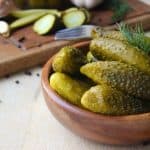
Gherkins are a group of cucurbitaceous vegetables used mainly as salads or pickles. They are a distant cousin of the cucumber.
Pickling cucumbers, or pickles as they are generally known, are larger in size while gherkins are smaller. The scientific name for both varieties is Cucumis sativus. More than 70% of cucumber crops grown in the United States are used for making pickles.
Gherkins are also pickled frequently as they are smaller and many people prefer the smaller size for their pickles.
Let us take a look at gherkins, their benefits, and some ways to preserve them as pickles.
What are gherkins?
Gherkins are small, prickly, cylindrical green vegetables having thin green rinds and white flesh. They are great in salads and for making pickles.
Historians estimate that gherkins and cucumbers may have existed for nearly 10,000 years. Early explorers and travellers brought back cucumber varieties from Asia for their skin-healing properties.
Early colonists introduced gherkins and pickling cucumbers to the United States in the 17th century, although, the idea of pickling cucumbers can be attributed to Spain. Pickles were considered a necessary condiment in the country and the Roman emperors valued them greatly as well.
Benefits of gherkins
Vitamins and minerals
Gherkins and pickling cucumbers have numerous health benefits. Their flesh is a rich source of vitamins A and C as well as folic acid, while their skin is rich in fibre and minerals like silica, potassium, magnesium, and molybdenum.
Heal skin issues
Cucumbers and gherkins have been used for healing skin problems for centuries. The ascorbic acid and caffeic acid in these vegetables prevent water retention.
That is why when you place cucumber slices on your eyes, you feel immediate relief from burning and swelling. This is one of the best remedies for puffy eyes as well as under-eye dark circles.
Beneficial in weight management
Gherkins and pickles are great for weight watchers since 3 ½ ounces or 100 gram serving provides only 12 calories.
How to select gherkins for pickling?
Select fresh-looking small, well-shaped gherkins. Ideally, they should be green to medium-dark green in colour. Avoid puffy, yellow coloured gherkins. Also, avoid ones that have a soggy, water-soaked, or wrinkled appearance.
Print
Gherkins in Vinegar Recipe
- Total Time: 10 minutes
Description
This is an easy and delicious way to enjoy gherkin pickles. They are fermented overnight and need to be used up right away. Gherkin pickles in vinegar are ideal in salads, subs, burgers, and wraps.
Ingredients
- 4–5 Small sized, fresh gherkins
- Apple cider vinegar – As much as can submerge the pickles fully
- 2–3 sprigs of aromatic herbs like dill, parsley, crushed garlic, spices etc (optional)
Instructions
- Wash the gherkins under running water.
- Dry them with a clean cloth.
- Peel the gherkins.
- Place the peeled gherkins in a glass jar.
- Pour natural apple cider vinegar in the jar until the gherkins are fully submerged.
- Add the spices/herbs if using.
- Keep the pickle overnight. You can consume these fresh, crunchy, and tangy pickles right away. They are great in salads, inside burgers and wraps, and pretty much in any dish as condiments.
- Cook Time: 10 Minutes
Conclusion
Are gherkins the same as pickles? The answer is that gherkins are distant cousins of cucumbers, smaller in size, and also useful as alternatives to pickling cucumbers.
Gherkin pickles are fantastic inside subs, wraps, and sandwiches. I am sure you will like both recipes given above.
Recommended
How to Make Pickled Cucumbers at Home

Leave a Reply